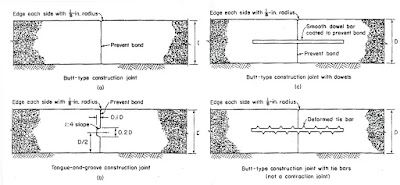Concrete Joints
Concrete joints are placed in the concrete to compensate for the expansion and contraction of the materials due to weather conditions.In order to avoid cracks, concrete installers will predict where the concrete will cracks and how it will expand based on there assessment they will create forming, saw, tool and place joint formers at different locations.
Concrete joints can be classified in following categories:
Construction joints are made before and after interruptions in the placement of concrete or through the positioning of precast units.Concreting operation should be so planned that the work is completed in one operation.Location are usually predetermined so as to limit the work that can be done at one time to a convenient size,with least impairment of the finished structure,through they may also be necessitated by unforeseen interruptions in concrete operations.Construction joints may run horizontally or vertically depending on the placing sequence prescribed by the design of the structure.
Best location of thee construction joints are as follows:
- Beam: Joint may be located at mid-span or center of the column in direction at right angles to the length of the beam.
- Column: Joint should be located a few centimeter below its junction with the beam.
- Slab: Joints may be placed at mid span or directly over the center of the beam, at right angle to the slab.
2. Expansion Joints
Expansion joints are designed to allow for expansion of the concrete, due to the rise in the temperature above the temperature during construction.Expansion joints also permit the contraction of the element.They are commonly found between sections of building, bridges, sidewalks, railway tracks, piping system, ships and other structures.The open gap of expansion joints varies between 2 cm to 2.5 cm. In case of transfer the load from one slab to the adjacent slab, dowel bars are used at suitable intervals at these joints.Expansion joint movement may be high upto 30% of joint width.
3. Contraction Joints
Contraction joints are provided to permit contraction of the concrete.These joints are spaced closer than expansion joints.These joints are purposely designed to regulate cracking that might otherwise occur due to the unavoidable, often unpredictable, contraction of concrete.These joints are often called controlled joints because they are intended to control crack locations.Contraction joint movement is supposed to be small.
4. Warping Joint
Warping joints are designed to relieve stresses induced due to warping effect.These joints are also known as hinged joints.









No comments:
Post a Comment
If you have any doubts, Please let me know.